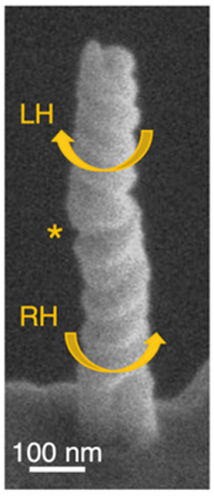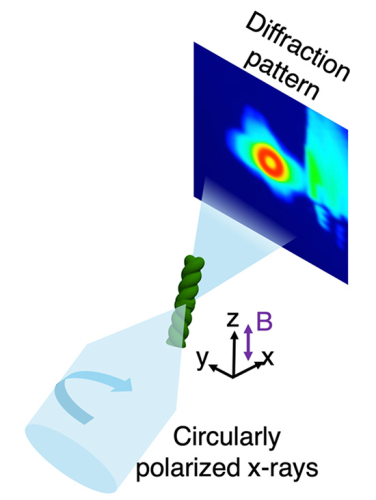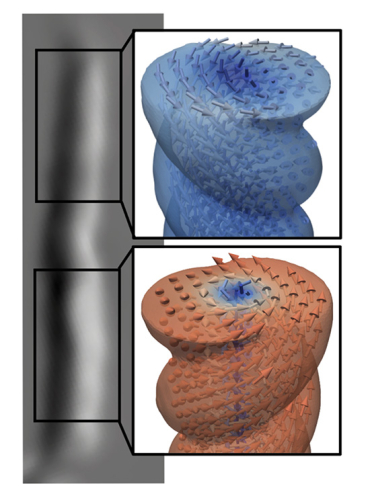Scientists have used 3D printing to shape nanomaterials that mimic the twisted structure of DNA, revealing new ways to control magnetism through geometry. An international team —including researchers from SOLEIL’s HERMES beamline, Argonne National Lab, Loughborough University, and TU Wien— has shown that these chiral magnetic structures can host complex magnetic vortices.
Using X-ray magnetic ptychography at SOLEIL, they imaged these states with high precision, showing how 3D shape can drive magnetic behavior in future computing technologies.
An international team of researchers has demonstrated how geometry can be used to control magnetism at the nanoscale by 3D-printing artificial nanostructures that mimic the shape of DNA. This work opens new directions for developing next-generation magnetic devices that could be used in advanced computing.
Many objects in nature are chiral, meaning they have a “handedness” and cannot be superimposed on their mirror image—like your left and right hand, or the famous double-helix of DNA. In nanomagnetism, scientists are especially interested in creating chiral magnetic textures, such as vortices and skyrmions. These tiny, swirling spin patterns could one day be used to store or process data in magnetic memory or logic devices.
Until now, most magnetic nanostructures are flat and two-dimensional. But researchers are now investigating how three-dimensional geometries could unlock entirely new magnetic behaviors, which require new tools to build and observe them.
Using cutting-edge 3D nanoprinting, the team created tiny cobalt structures shaped like a double helix—similar to a strand of DNA, but made of a magnetic material (figure 1). This structure included both left-handed and right-handed twists, providing a platform to explore how geometry affects magnetic properties.

Figure 1 : Image en microscopie électronique de la double hélice de cobalt imprimée en 3D, combinant une région à chiralité droite (RH : haut) et une région à chiralité gauche (LH : bas), se rejoignant au niveau du plan noté *.
Because cobalt is magnetic, the shape of the nanowire promotes the formation of vortex-like spin textures that match its chirality. But due to the structure’s complexity, even more exotic magnetic states can emerge.
SOLEIL’s key role: imaging magnetism at high resolution
To observe these magnetic states, the team used X-ray magnetic ptychography at the HERMES beamline at SOLEIL synchrotron. This imaging technique developed at HERMES combines STXM and coherent X-ray diffraction. It allows researchers to achieve extremely high resolution, no longer limited by the diffraction of traditional optics.
With X-ray magnetic ptychography (figure 2), they were able to directly visualize how magnetic spins were arranged in the nanowires under different conditions.

Figure 2 : Schéma de la technique de ptychographie magnétique par rayons X utilisée sur HERMES pour imager l’état magnétique de la nanostructure en double hélice.
They found that at zero magnetic field, the nanowire hosted magnetic vortex tubes whose chirality matched the structure’s shape. By applying and removing an external magnetic field in a specific way, they could also create a more complex state: a fractional skyrmion, where the alignment between magnetic and geometric chirality was broken in some regions (figure 3).
These observations confirm that the 3D geometry itself—not just the material—is key to controlling the magnetic state.

Figure 3 : Image obtenue par ptychographie magnétique par rayons X de la nanostructure en double hélice et simulations des états magnétiques associés (vortex en haut et skyrmion fractionnaire en bas) dans les deux régions chirales.
This work was carried out by an international collaboration including researchers from SOLEIL Synchrotron (HERMES beamline), Argonne National Laboratory, Loughborough University, TU Wien, Cambridge University, Laboratoire Albert Fert, the Max Planck Institute of Chemical Physics of Solids, and the University of Glasgow. The work was primarily funded by the ERC project 3DNANOMAG. The imaging capabilities of the HERMES beamline made it possible to observe and validate the magnetic textures directly.
This breakthrough provides a new way to design and control magnetism in 3D—by using geometry as a tool. Next steps will include fabricating even more intricate 3D nanostructures to explore other exotic magnetic states, including knotted or topologically protected textures.
By deepening our understanding of how geometry and magnetism interact, this research paves the way for new magnetic technologies that are smaller, faster, and more efficient, key for future green technologies. It also highlights the power of advanced imaging techniques—like magnetic ptychography at SOLEIL—to image complex magnetic states at very high resolutions.
